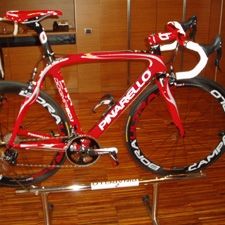TREVISO, Italy (BRAIN)—On the eve of the Pinarello Granfondo in its hometown of Treviso, Pinarello unveiled the Dogma 60.1 road bike (pictured) to the company’s global distributors, sales reps and select dealers. The company built up the first 300 Dogmas for its guests to ride during the race through the beautiful countryside of the Veneto region.
Fusarpoli said two years ago when the company introduced the Prince, his concern was would Pinarello be able to improve upon it. “It was for sure the best bike until this morning,” Luciano Fusarpoli, Pinarello’s international sales manager, said of the Prince.
But the Dogma has dethroned the Prince as its top of the line road bike. “At the end we were successful. We think we have the best road racing bike ever built,” Fusarpoli said.
The Dogma weighs 890 grams—100 grams less than the Prince. Pinarello achieves this weight reduction with an asymmetrical design that uses less material on the left side of the bike because that side endures less stress than the drive side. A close inspection shows that the right sides of the rear stay, fork, top tube and chain stay have slightly larger tube sections. Fusarpoli said paradoxically the design makes the bike more balanced.
Pinarello also steps up from a 50HM1K carbon fiber used in the Prince, to an exclusive 60HM1K (basically more fibers within a square centimeter) weave it developed in conjunction with Toray, the biggest Japanese manufacturer of composites. Toray supplies carbon fiber for numerous commercial applications including the world’s largest aircraft, the Boeing 787 Dreamliner and Airbus A380. Fusarpoli said that the 60HM1K weave is 29 percent stronger than the 50HM1K weave. And the addition of nanotechnology, the fusion of nano elastomers that absorb impact into the resin, makes the material 59 percent more resistant to cracks after impact.
To manufacture the frame, Pinarello introduced an EPS process in which it lays up the carbon fiber around a polystyrene form. When the carbon is heated in a mold, the polystyrene melts and drips out. The result, Pinarello claims, is a smoother, wrinkle-free frame interior that has less possibility of defects.
In addition to its engineering story, the bike has flashy graphics with sparkly silver decals that the company refers to as its diamond finish. (Leave it to the Italians to add some serious bling.) “The first thing the consumer sees is the visual aspect of the bike. We need to catch the eye of the consumer and then we have the characteristics to convince them,” Fusarpoli said.
Scott McAhren, owner of Conte’s in Arlington, Virginia and Bethesda, Maryland, said he has had a ton of success with the Prince this year and will bring in the Dogma to replace it. “We’re all about the new,” he said. Despite the weak economy, McAhren said he hasn’t seen a slowdown in high-end sales and expects the Dogma to sell well. “We sold more $15,000 bikes in the last year than I thought possible,” he said, attributing high-end sales to the Washington, D.C. market, which is full of government contractors and defense contractors who feel secure in their jobs.
Chris Goodwin, buyer for Pinarello’s U.S. distributor Gita Sporting Goods, said that despite the tough economy, he expects Gita to sell as many Dogmas next season as it sold Princes in its first year.
Gita will have framesets in stock Oct. 1. They will be available in the States in four colors, 11 sizes and retail for $5,500.
—Megan Tompkins


